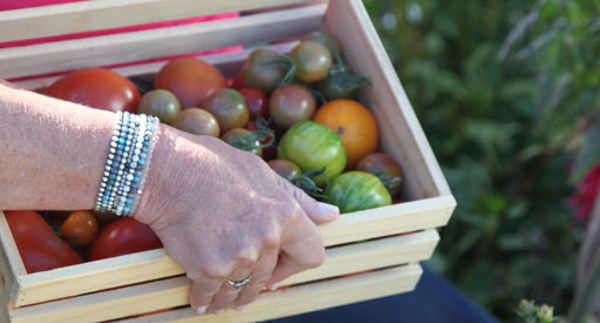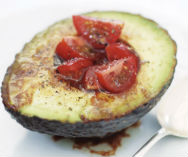
My father Fred was famous for his tomatoes. His vines produced prolifically, and the fruit was always amazingly sweet and flavoursome. For Fred, growing good tomatoes was all about seaweed. Once or twice a year, we kids would be enlisted to help him gather the fine seagrass weed that grew in the tidal estuaries around Pauatahanui. Vast rafts of this stinky stuff would wash up after a big storm and we would walk for miles to fill big sacks of the stuff, then lug them back down the long beach before the tide got too high. The sacks were so heavy it always took two of us to hiff them into the boot.
Shopping list
My father had brought his red-finned Plymouth back from the States, and it was his absolute pride and joy, so it seems so counterintuitive that he would be filling up the boot with this rust-making, foul-smelling stuff. The drive home always had us with our noses held tightly plugged, and the weed’s awful rotting odour permeated every nook and cranny of the car for weeks – it was truly hideous. But for Fred this was the black gold that made his tomatoes (and the rest of his garden) flourish. Thinking about it, that’s possibly why I am so crazy about Seasol – as a natural seaweed concentrate it has all the benefits and goodness of seaweed without the smell and drama!
Dad would start his tomatoes in late winter, setting his seeds to germinate in little plastic trays, covered with mum’s showercaps over the night store heater. These days, my mini greenhouse makes the germination process really easy and gets my tomato seedlings started inside while it’s still cold.
Be sure to choose a different bed each year in which to plant your tomatoes and don’t plant them where you have grown potatoes, as year-to-year diseases like blight can hang around in the soil.
I always dig in lots of compost and some Tui Sheep Pellets and before I plant my seedlings I give them a good soak in diluted Tui Organic Seaweed Plant Tonic. Then I feed them again every four weeks or so through the growing season.
If you are growing tomatoes in pots or containers, a good quality tomato mix, especially blended to give tomatoes all the nutrients they need, is key. Once the plants are established, whether in pots or the open ground, I sprinkle a small handful of tomato food around the base every four weeks or so – it does wonders to boost flowering and fruit set, and the potassium in there also ensures your fruit will have great flavour. I always plant my tomato seedlings up to the first true leaves, as new roots quickly sprout on the stems, and more roots means more fruits!
There are so many wonderful varieties of tomatoes to grow these days – from multi-hued heirlooms with names like Green Zebra, Mortgage Lifter, Indigo Rose and Black Krim through to classic stalwarts like the giant beefsteak. Cherry tomatoes are prolific producers with a great flavour, and one of the first varieties to ripen. They look so pretty in salads and as a garnish. Often I roast trays of cherry tomato trusses, as they make a pretty side dish for meat chicken or fish or can be stripped off the vine and pureed up for a sauce. For sandwiches and toast and slow-baked breakfast tomatoes I love slicing into a big juicy beefsteak, and for a salad I like to mix up the colours and tastes with a selection of heirlooms. Any of the Italian oval tomatoes, Roma or paste tomatoes are great for homemade sauce and preserves as they tend to be more fleshy and pulpy, with fewer seeds.
I am fussy about taking out the laterals in all my staked tomatoes. These are non-fruiting branches, and taking them off directs the tomato plant's energy into growing bigger better fruit. Bush tomato varieties grow happily along the ground (though the slugs love the fruit), but all the other varieties need staking. Choose a 2-metre stake and put it in when you plant your seedlings as you can damage the roots if you try and do it later.
Tomatoes start flowering and fruiting from the base upwards as they grow, so as long as they keep growing and flowering you can get a harvest season for two or three months from a single plant. About halfway through the growing season I go through and prune the base leaves from my tomatoes, as it’s usually in the older leaves that fungal diseases like blight start.
Basil makes a great companion plant for tomatoes, repelling diseases and improving growth and flavour. Ditto for borage, chives, mint and parsley. Carrots and beans, marigolds, cucumber, cosmos, lettuce and peas are other good companions. Keep your plants regularly watered with a good soak around the base every four or five days and avoid getting the leaves wet.
When it comes to harvest time, store tomatoes at room temperature as they lose their sweetness when chilled. Towards the end of the growing season I pick all the fully formed fruit that is just starting to change colour and leave it in the fruit bowl where it will ripen up over about a week. Another good way to extend the season before the first frosts hit is to pull out the whole plant and hang it, roots and all, upside down in a dry warm shed. There are enough nutrients in the plant’s root systems to continue ripening the fruit for several weeks.
Even if you have a tiny balcony, it’s easy to grow a tomato plant in a pot or hanging basket. Just make sure it’s in a sunny spot, keep it well watered and well fed and you will be rewarded with a taste like no other!
Although best known as a cookbook author and publisher, Annabel Langbein is also a highly experienced and knowledgeable gardener. She studied horticulture at Lincoln University and for many years has grown her family’s fresh produce in her gardens and orchards in Wanaka and Auckland. Her seasonal harvests are the inspiration for many of the inventive but easy recipes in her new book and TV series in association with Tui
Avocados with Tomatoes and Balsamic Dressing
Prep time: 10 mins
Serves: 4
Ingredients
- 2 just-ripe avocados
- 8 cherry tomatoes
- Balsamic Dressing:
- 3 tbsp olive oil
- 1 tbsp balsamic vinegar
- 1 tsp dijon mustard
- ½ tsp sugar
- salt and ground black pepper, to taste
Method
- To make Balsamic Dressing shake together all ingredients in a small jar.
- When you are ready to eat, halve the avocados and remove the stones.
- Quarter the cherry tomatoes.
- Pile into the avocado cavities, drizzle with Balsamic Dressing and serve.
Read more of Annabel's guest blogs here
Post a comment
Growing Perfect Tomatoes Comments
Which type of tomato would be best for a hanging basket?
Maria
Hi Annabel, Interesting reading about growing tomatoes. I have been growing tomatoes and peppers for years in my glasshouse. I tried various companion plants and found marigolds were best to keep whitefly and other bugs off the tomatoes, just make sure they are dwarf marigolds. The first year I planted a larger variety and they grew as big as the tomatoes! Now I have retired and downsized to a townhouse after 33 years in my family home. I really miss the glasshouse so I bought a plastic "tent" hothouse from the Warehouse and I am growing 4 tomato varieties, 2 peppers & 1 cucumber in pots. I used loads of compost and some sheep pellets with the pot & tub mix & I always use a bit of blood and bone. They are doing well so far but I will get some Seasol and give them a boost with that, thanks for the tip. Yesterday we had a strong southerly wind and I had to go out and tie the "tent" to the fence as it was about to take off, good old Wellington southerly! I really enjoy your TV programme and envy your lovely garden! Happy gardening. Linda (in Lower Hutt)
Linda Webster
I'm looking forward to growing the perfect tomatoes this season will so much comprehensive information. Balsamic Dressing,simple and excellent!
Maggie
Nice article! I love home grown tomatoes - nothing beats the flavour. One point though - laterals will and do bear fruit if not taken out. Removing them and growing tomatoes as a cordon (single main stem) is a popular way to do it as it makes them easier to stake and control, but if you leave the laterals on, they will flower and bear fruit too.
Cynthia
Hi Cynthia, yes you are correct regarding the laterals, thank you for your tip! Thanks, Jenna - Tui Team
jenna
Hi Maria, the Tumbling Tom variety is best for hanging baskets. Happy tomato planting! Thanks, Jenna - Tui Team
jenna